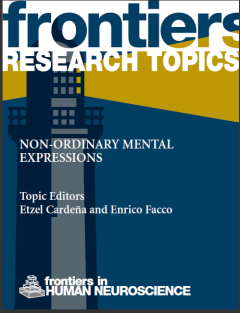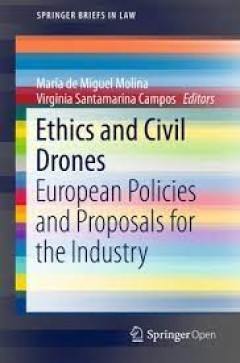Filter by

Non-Ordinary Mental Expressions
So-called altered states of consciousness (ASC) are an intriguing, still under-researched topic, with profound neuropsychological and epistemological implications. In the last few decades there has been increasing multidisciplinary interest in consciousness and ASC, a term encompassing a wide range of pathological and non-pathological conditions, including dreaming, near-death experiences (NDEs…
- Edition
- -
- ISBN/ISSN
- 978-2-88919-485-8
- Collation
- -
- Series Title
- -
- Call Number
- 613 NON

Ethics and Civil Drones : European Policies and Proposals for the Industry
This open access book disseminates some of the results of the European H2020 AiRT Project (Technology transfer of RPAs for the creative industry). In particular, it presents findings related to mitigating safety and security concerns when civil drones are piloted by the service sector (mainly, the creative industry). European policies regarding drones generally focus on outdoor drones, but they…
- Edition
- -
- ISBN/ISSN
- 978-3-319-71087-7
- Collation
- X, 92 halaman
- Series Title
- -
- Call Number
- 338 ETH
The Legal Effects of EU Agreements
Examining the legal effects of EU concluded treaties, this book provides an analysis of this increasingly important and rapidly growing area of EU law. The EU has concluded more than 1,000 treaties including recently its first human rights treaty (the UN Rights of Persons with Disability Convention). These agreements are regularly invoked in litigation in the Courts of the member states and bef…
- Edition
- -
- ISBN/ISSN
- -
- Collation
- -
- Series Title
- -
- Call Number
- 340 MEN l
Evidence : Jury Impeachment
The anti-jury impeachment rule, contained in Federal Rule of Evidence 606(b) and state counterparts, is a rule preventing the admission of jury testimony or statements in connection with an inquiry into the validity of the verdict, subject to certain exceptions. Through a series of cases and hypotheticals drawn from actual cases, this chapter gives readers a roadmap for how to address any jury …
- Edition
- -
- ISBN/ISSN
- -
- Collation
- -
- Series Title
- -
- Call Number
- 340 MIL e
Bankruptcy Law and Practice
This is the first edition of Bankruptcy Law and Practice, a Casebook Designed to Train Lawyers for the Practice of Bankruptcy Law. It is designed for a one-semester course in debtor/creditor law and bankruptcy. The book deals with both creditor remedies and debtor protections, starting with state law collection remedies, exemptions, and the important special protections for secured creditors un…
- Edition
- -
- ISBN/ISSN
- -
- Collation
- -
- Series Title
- -
- Call Number
- 340 GER b
Torts : Cases and Contexts Volume 1
Plain-spoken and convivial, this casebook makes a deliberate effort to explain the law, rather than to provide a mere compilation of readings and questions. Simple concepts are presented simply. Complex concepts are broken down and accompanied by examples and problems. By being clear and straightforward, the casebook aims to quickly get students to the point where they can navigate regions o…
- Edition
- -
- ISBN/ISSN
- -
- Collation
- -
- Series Title
- -
- Call Number
- 340 JOH t

Introduction To Linear, Time-Invariant, Dynamic Systems For Students Of Engin…
Permission of the author is granted for reproduction in any form of this book or any part of this book, provided that there is appropriate attribution, for example, by a citation in the References section of a technical article, and provided that the reproduction is not made for the purpose of charging a fee to users (e.g., students in a class) beyond the cost of reproduction. However, plagiar…
- Edition
- -
- ISBN/ISSN
- -
- Collation
- -
- Series Title
- -
- Call Number
- 624 HAL i
Evidence : Best Evidence Rule
The Best Evidence Rule, contained in Article X of the Federal Rules of Evidence (Rules 1001-1008) and state counterparts, is a Rule that requires a party seeking to prove the contents of a writing, recording, or photograph to produce the original (or a duplicate) or account for its nonproduction. Through a series of cases and hypotheticals drawn from actual cases, this chapter gives readers a r…
- Edition
- -
- ISBN/ISSN
- -
- Collation
- -
- Series Title
- -
- Call Number
- 340 MIL e
Civil Procedure : Pleading
This chapter covers the Civil Procedure topic of Pleading: The Plaintiff‘s Complaint. The chapter takes approximately four class periods to cover in detail. The student is exposed to cases, presented with questions that are designed to both guide class discussion and to help the student focus his reading of the materials, pleadings from cases, and the applicable Federal Rules of Civil Procedure.
- Edition
- -
- ISBN/ISSN
- -
- Collation
- -
- Series Title
- -
- Call Number
- 340 LEV c
Contract Doctrine, Theory & Practice - Volume 1
This is the first in a series of Contracts casebooks. It was originally titled "Collaborative Teaching Materials for Contracts." The first semester of law school is mostly about learning to speak a new legal language (but emphatically not “legalese”), to formulate and evaluate legal arguments, to become comfortable with the distinctive style of legal analysis. We could teach these skills…
- Edition
- -
- ISBN/ISSN
- -
- Collation
- -
- Series Title
- -
- Call Number
- 340 VER c
 Computer Science, Information & General Works
Computer Science, Information & General Works  Philosophy & Psychology
Philosophy & Psychology  Religion
Religion  Social Sciences
Social Sciences  Language
Language  Pure Science
Pure Science  Applied Sciences
Applied Sciences  Art & Recreation
Art & Recreation  Literature
Literature  History & Geography
History & Geography